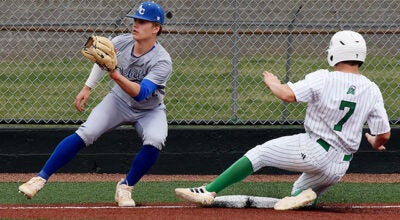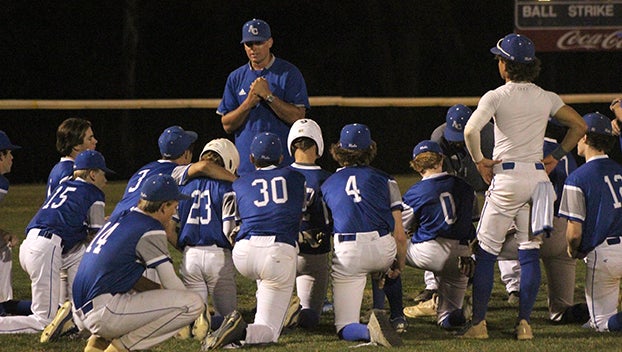Consistency is key for baseball mechanics
Published 12:20 am Sunday, April 1, 2012

Adams County Christian School pitcher Jake Brumfield works with his father on the proper pitching technique in baseball. (Photo illustration by Lauren Wood)
NATCHEZ — Adams County Christian School’s Jake Brumfield was a young boy when he stood face to face with his father, Spanky, and mirrored his movements to learn the proper pitching motion.
Jake, now the right-handed ace for the Rebel baseball team, followed his left-handed father’s every movement to learn his pitching mechanics.
Other young pitchers find their mechanics in a variety of ways and no two deliveries are identical. But there are fundamental aspects of every pitcher’s motion that need to be present for that pitcher to be effective and stay healthy.
Spanky, who is now the volunteer pitching coach for ACCS, used a six-step method (rock step, pivot, balance point, stride, release and follow through) to teach Jake the proper wind up when he was young, and he said proper mechanics need to be taught at a young age.
“By the time you get (to high school) you can either pitch or you can’t,” Spanky said. “If a kid really can’t do it by the time he gets here, it’s hard to try to teach a kid, because you can’t go changing the way they throw the ball.”
Spanky said when it comes to monitoring the mechanics of his pitchers he tries to focus on three things: grip, keeping their front shoulder closed and follow through.
“The main thing is just don’t fly open and drag your arm behind you,” Spanky said. “When they want to fly open and drag their arm behind them, you tell them to stay closed and drive through the ball.”
Spanky said effective mechanics are all about consistency.
“Just doing the same wind up and same motion every time (is key),” he said. “That’s the only way they can stay accurate. With a different wind up and different delivery every time, they can’t be accurate.”
Through Spanky’s tutelage, Jake now coaches himself and has the ability to mentally throw each pitch before it leaves his hand, Jake said.
“I just throw every pitch in my head,” Jake said. “I know that my curve ball has to come by my ear, my fast ball I have to rip through with my wrist and my slider I actually taught myself how to throw.”
Jake said he was watching the MLB Network and they were teaching viewers how to throw a screwball.
“I was like if I do the opposite of that what will it do? I got out there one day and tried it, and it’s been my best pitch ever since,” he said.
“I just modified it from (the TV) to fit me. I act like I have a knife in my hand and stab my hip (when I throw it).”
Breaking pitches can be a hot-button issue for parents and coaches trying to teach their children how to pitch, Spanky said.
“Everybody has a different view of that,” he said. “I know some kids who have been throwing curveballs since they were 9, and they are fine. And some kids don’t start throwing until age 13 or 14 and their arm hurts. All kids are different.”
Throwing a baseball is not a natural arm motion, whether the pitch is a 95 mph fastball or a looping curveball, and coaches stress the importance of pitching with the whole body and not just the arm.
“We try to make sure they have a good follow through and leg drive,” Cathedral baseball coach Craig Beesley said. “Anything we can do to keep stress off the shoulder and the elbow.”
Alcorn State head coach Barret Rey said lower body mechanics are crucial when his team starts looking at pitching prospects.
“We basically want them to have a solid base of understanding how to use their lower half, opposed to using just the upper half,” he said. “You have to have them both working together, and that will give you longevity with your arm.”
Beesley said he has had several pitchers learn to throw new pitches, including breaking pitches, and when it comes to adding a pitch, players have to start from the beginning.
“It’s all about mechanics when we try to add a pitch to their repertoire,” Beesley said.
Jake said his first experience with a breaking pitch came before his coaches wanted him to start using his wrist to manipulate the spin on the ball.
“When I was little, people didn’t want you throwing real curveballs, because they said it will hurt your arm, but I threw a cut (fastball), which is a stiff-wrist pitch you throw like a football.”
Rey and Beesley also emphasized the importance of strength training to keep pitchers’ joints safe.
“We work on strengthening up the muscles that may not have been strengthened up in the past, especially the back,” Rey said. “Proper weight training and not overusing them as far as pitch count is important.”
Beesley said assistant coach Ron Rushing works with Cathedral’s pitchers to strengthen their core to keep them from putting too much stress on their arms.
Rey said before the season starts, Alcorn’s pitchers start from scratch to get their arms back into shape.
“We really want to start from the top and go back really to square one to get the guys to go back to mechanics,” Rey said.
Rey said his pitchers start throwing off their knees to make sure their arms are moving properly, and then progress to throwing from flat-ground to work on their leg drive before they step onto a mound.
Proper mechanics are stressed to prevent injury to the joints in pitchers’ arms, and especially to prevent damage to the ulnar collateral ligament in the elbow, which could lead to Tommy John surgery.
“The main injury we’ve had to deal with here is Tommy John,” Rey said. “It’s one of the more noticeable injuries and one that you hope guys can prevent.”
Beesley and Spanky Brumfield said they have had good fortune with injuries at Cathedral and ACCS. The Rebels’ Christopher Perry did have Tommy John surgery last year, but his injury was not a result of pitching.




